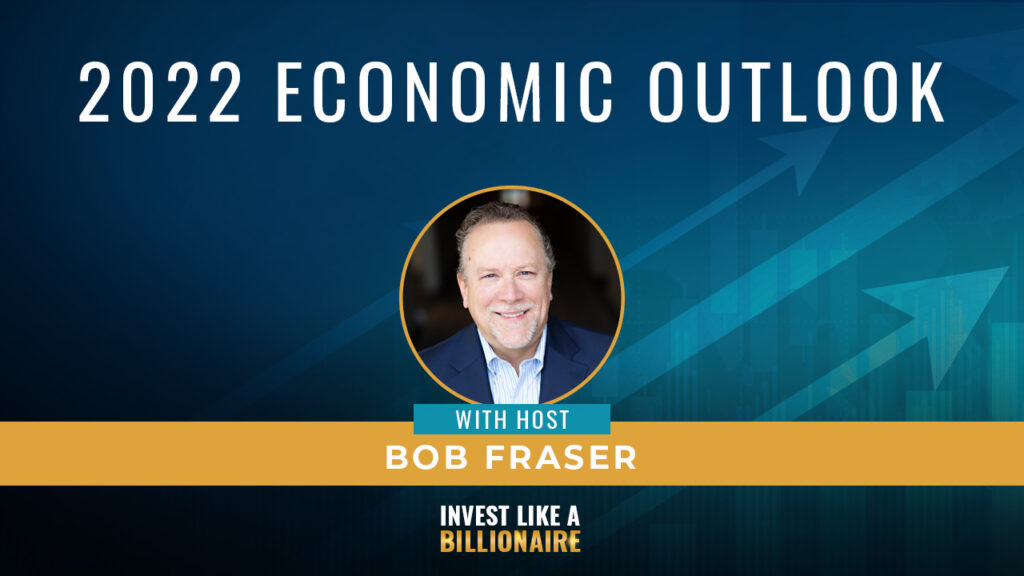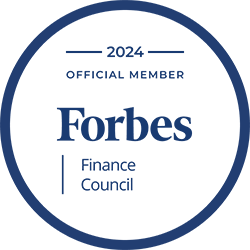What To Expect For The Rest of the Year

In this week’s episode Bob Fraser discuss the future of inflation, CRE cap rates, housing sales volume and prices, if a recession is about to happen, and what these imply for investors. So if you’re curious about where the market is headed, make sure to listen or watch.
—
Watch the episode here
Listen to the podcast here
2022 Economic Outlook with Bob Fraser
What To Expect For The Rest of the Year
Welcome back to the Invest Like a Billionaire Podcast. We’ve got a great episode for you today, and today is a little bit different and it’s actually a recording from a few weeks ago from our Annual Shareholder’s Event. So we do an event for our shareholders every year. And as part of that, Bob Fraser goes through an economic update. And given the current environment just where we’re at right now with the economy, rates are going. Inflation’s still really high. A lot of people are concerned about the recession. We thought that this presentation would be really valuable to share with more than just our investors, but with our broader listenership on the podcast, these are the same questions a lot of people are asking.
And so this is a little bit different than normal. It’s really more of a presentation that Bob went through. And so I would highly encourage you if you have the ability to watch this episode on YouTube and you’ll be able to see the presentation and the slides, there are a lot of slides and graphs that are he’s gonna be referencing.
So it’d be a lot more helpful if you can watch it. You’ll be able to listen to it and glean a good amount of information from it that way. But if you can watch it definitely encourage you to do that. And if you wouldn’t mind liking commenting, subscribing to our YouTube channel, that really helps us continue to grow this show and get in front of more people, just like you, that are looking to be educated on investing.
And with that, I hope you enjoy this episode. Thanks so much for listening.
Bob Fraser: Those of you who know we’re passionate about economics.
I personally spend many hours a day every day reading and studying economics to really understand what’s going on on the planet and what it means for us. So some of the highlights here that I’m paying attention to course inflation is the big thing.
Here are my summaries. I believe, we will see inflation moderating, but it’s also gonna persist stubbornly throughout this year, and next year. There are a lot of people calling for a recession. I’m not seeing it yet could happen not yet. I’ll go into why. We’re seeing commercial real estate cap rates rising right now on because of basically debt rates are increasing.
And so we’re seeing a lot of, particularly in multi-family the cap rates actually below the debt to buy the property, which is nuts. But we’re so not, but we’re not seeing cap rate significantly moving and probably will not cease cap rate, significantly moving. And of course, in the housing market we are seeing high mortgage rates slowing sales volumes, and surprisingly or not prices continue to rise.
So we’ll dive into some of these trends here. This is on inflation. This is just a little backup Goldman Actually Goldman Sachs actually called me and agrees. So no I’m joking. They basically concur that that basically strong inflation will keep the sequential pace of core PSD elevated throughout year-end, but year over year inflation core inflation will decline further in the coming months as last year’s sharp goods, and price increases drop out.
So they’re basically seeing predicting that inflation rates are gonna basically moderate a little bit as we come down. The GDP print. So big headlines GDP came in dropping 1.4% and everybody’s freaking out and saying, recession, the sky is falling and it’s not.
And I’ve actually said, we’re seeing incredibly strong consumer demand, incredibly strong savings consumer numbers, and they continue to be strong. I wanna look in detail at the GDP print. This here. So this is the detail. These are the components. And you can see consumer spending was very strong right here.
Investment is strong. What, where we saw the negative print was net imports and exports. So this is as basically We’re importing goods versus exporting goods. It negatively impacts GDP and investment. So people are, companies are basically building in inventory in, in that.
And so this basically caused, and then the government spending. Two individuals also de decrease. So we’re seeing these things. This is all temporary. This is all temporary stuff nothing lasting and nothing. That actually is signaling a real recession yet. So again, let’s see what happens in Q2.
We are seeing. Weakness in a lot of the economic data coming out remains to be seen, but I’m not seeing a recession yet. Could the fed cause a recession? Absolutely. They seem bent on that. You ought to talk about it. Will they pause in the fall in September? That is certainly possible would not be surprised to see that happen.
You’re going to see, continued growth, but there’s so much strength in the economy right now in the underlying economy. And so much demand that I actually expect us to not go into recession at this time. There’s been a lot of talk about affordability. I love this chart, housing affordability, and rent, rent affordability.
And so what this chart shows since 2000 the top line is your housing payment right here. And the bottom line rents. And so you’re seeing as housing prices have. During the great recession here you saw this gap where rents were, housing was, as cheap as rents.
Then as the housing prices have taken off, you’ve seen rents tracking, but below. And so we’re seeing this gap. It all looks very healthy to me. We’re seeing as home prices rise, rents rise, and both are protection for one another. As home prices rise that makes renting more attractive. As rents rise, it makes buying a home more attractive.
So both things are supportive and neither one is outta whack. So it just, nothing seems out of whack to me, inflation is hurting a lot of people and these things are getting increasingly, it’s increasingly challenging at the same time you’re seeing, or you’re seeing a lot.
A lot of, COVID cause a lot of older people to pass on, we’re seeing that younger people have made some inheritances, they came into cash, they’re buying houses and you’re seeing younger people, millennials, and others doing household formation.
And so it continues to drive up demand and we’re seeing demand statistics continue to just peg the needle. Here are some of the things, that I think may shock people. If you look at it, so this is the pandemic here, right? And this is retail sales look what’s happened.
So during the pandemic, you saw retail sales crash. And since then it’s been on fire. It’s exactly what we’ve been saying. People are basically flush with cash. You’ve seen a 20% increase in household net worth since COVID in us consumers and a 15% in increase in household earnings per capita.
Since COVID so households are flush and what are they doing? There’s they’re getting out of the house and they’re spending money 26% increase. And I’m indebted to Marcus. Millerat encourages you to sign up for their website. They have great economic data. So this is from Marcus Millerat. So you’re seeing retail sales have just been on fire.
And these are the deposits, total savings deposits, and money market mutual fund deposits. Look what happens. So during COVID, individuals saved and today they estimate $5.7 trillion in excess savings on our individuals, balance sheets. So people are just sitting on cash, they’re flush with cash.
And so they’re traveling, they’re spending they’re buying houses. They’re investing. Again, this is underlying, this is the fuel. That’s fueling the economy right now and it’s not stopping. So not yet commercial real estate. I’m gonna hit about that a little bit.
This is the transaction volume since 2017. And you’re seeing a ma literally last year was more real estate transactions than have ever happened in history. So we’re seeing a lot of activity of those of us that are active in the commercial real estate field are, can attest that, that it is just on, on fire right now.
Why while you can see here are the returns. So commercial real estate, since 2000 has out outpaced the S and P 500 quite, quite a bit. And especially with the volatility in the markets, it just makes commercial real estate that much more. Competitive in office space. Our office is not a space we are very excited about right now, although we just are hearing some strategies that may make a lot of sense.
We’ll not be ready to talk about those there will be a time when it makes sense. To get into office space. So here’s what happened. This yellow line is the vacancy rate. So you saw it dropping UN until COVID and then all of a sudden vacancy has just shot up and This is new construction, and this is basically net absorption.
And so you can see there’s a lot more supply than there is demand and demand is uncertain. We’re not excited about the office right now and not gonna be doing anything in the office at this time. Senior housing is another one with pretty high vacancy rates and COVID killed it. And this is an industry major transition.
I don’t think people know what’s gonna happen here. And so we’re not very excited about senior housing. Right now. Retail this is nuts. Multi-tenant retail. So you see vacancy rates dropping all of a sudden they spike up during COVID, but now they’re dropping again.
And so we’re seeing huge demand. Now, this is all retail, the retail. That Aspen is especially excited about neighborhood retail, which is the very small strip centers. And these are the ones with your dog groom or your neighborhood, nail salon it’s et cetera.
So these are the ones super, super bullish on. Hotels, surprisingly are
coming back. Hotels are not something we’re excited about yet, but we’re seeing massive comebacks here. Now I want to get into some of the things we are very excited about. So if you look since 2008 look at the vacancy rate just crushing down. We’re seeing a vacancy rate approaching 2%, which is basically no vacancy in apartments.
And the vacancy rates are just nuts. These dark lines here are the completions. This is new stuff being built and you can see it’s being built. And then this is the absorption. How much is actually being rented out? And there’s just more absorption happening than stuff that’s being built as facets it’s being built.
It’s being rented. This underlines the strength in the market right now, there are massive weights, and massive waiting lists in almost all. Multi-family kind of in all urban areas, in suburban areas, across the United States. There’s just a huge vacancy, a huge problem with not enough spaces and huge demand.
So this is what’s underlying this, the strength here. And the multifamily is really the gold standard of commercial real estate because it doesn’t matter what happens to the economy. People need a place to live, and it is inflation-protected very well, nicely inflation-protected. And if you can get good debt terms, you can make money in inflation on both the positive and the negative on the growth and the rents as well as being a debt holder and watching your debt being deflated away.
Bob, do you have any insight on, this is a random question, but for the 19, for the 21 years of 21, then, that net absorption being like way outta line with every other year, you know what,
You saw the vacancy rate. So you see the vacancy, basically, everything that was available dropped. So a vacancy rate went from what, four and a half percent to, yeah.
That’s two and a percent. Yeah. That’s because the units were absorbed, but what car they were absorbed. And so people, yeah, 21, everybody decided to get an apartment and move out. And so millennials are forming households and they’re doing this And there’s just not enough construction, so the great financial crisis put construction on hold.
And so we’re dealing with a massive backlog right now of demand in industrial and in single-family and multi-family housing. So now it’s catch-up time. With when rates are 2% vacancy rates, you are gonna see prices go up. This is just a squeaker of a market. There’s, it’s a seller’s market like crazy.
Will there be a day when it’s overbuilt? Absolutely, but it’s not gonna happen for a few years. One of the other trends we love is a self-storage and look at the vacancy rates here. Again, there’s a theme, vacancy rates just coming down in spite of this, look at all this. Net new construction and absorption.
So vacancy rates are at an all-time low in, in self-storage. And absorption is just there. One of the, one of the trends, of course, and it’s soared through COVID look what happened through COVID. It just, it didn’t, it literally didn’t take a hit at all. And so one of them, one of the things as rents are going up and square footages are going down, people wanna store their stuff, so people need storage.
And so you’re seeing a lot of demand. Americans love their storage, and it’s just a fantastic market. And as, as Ben has pointed out, there is no real. Out there that is more inflation-protected than storage. You can raise yourself, if you have a one-year lease in your apartment complex, your rents can be raised every year.
But in storage, these are, these are month to month or terms these things rents can go up on every 30 days if you need to. So they’re super, a lot of just very amenable to inflation and And as Ben said, price in elastic. So if you’re increasing rent by 25% and you’re increasing your rent from, $30 to, $36 a month, it’s not that much, not that big of a deal to a person versus their apartment rent.
That’s going up to $300 a month. So it’s much more affordable. This is one of the areas, that we are most excited about. If you look at, industrial absorption, look what happened last year, more absorption that’s ever been in history in this in industrial VA in industrial. It’s nuts.
This is insane. So again, look at the vacancy rates dropping. We’re literally under a 4% vacancy rate, which is basically no vacancy. In industrial in spite of. Of, a lot of new construction going on. It’s just not enough to meet demand. What’s happening here. And again, so during the great financial crisis building got way behind there wasn’t enough stuff built.
Meanwhile, throughout the last 10 years, you’ve seen eCommerce requiring lots of warehouses. Think of Amazon needing warehouse space. Cetera. So they’re busy acquiring all this warehouse space and E eCommerce is growing what’s happening lately is eCommerce. We’re starting to see the eCommerce trend plateauing.
It doesn’t mean eCommerce is stopping. It just means the growth is beginning to slow down. Just as that happens, look what happened in 21 and 22. We’re seeing two brand new trends emerge that are just as powerful as e-commerce just as powerful and they’re just getting started. And that is one of the desires to reshore to America.
And so what’s happening in manufacturing during the 90s, the globalization trend. Everyone wanted to save a dollar or save a dime by moving to China, sourcing from China. And, if you could save a dime under your pro your product right now, it’s actually cheaper to manufacture in Mexico than in China and in transportation to China.
So the shipping for the freight rates has gone up 10 times. So people are wanting to come back to America besides the fact that, as car manufacturers are not shipping cars because they can’t get a little tiny couple dollar chip. What’s it worth for them? They’re happy to pay.
I’m sure. Double the price of that chip in order to get us manufacturer to manufacture that chip. So we’re seeing tons of manufacturing coming back to America. It is not that much more expensive manufacturing rates in America are roughly three times what they are in Mexico. And once you add robots and automation, it ends up being about the same.
And so we’re seeing massive reshoring trend, the globalization of the 90s that took place over the decade of really the, and the really the two decades beginning of the 90s is over. We’re seeing a massive de-globalization trend that is gonna take another 10, 15, or 20 years to play out.
That’s just getting started. The other thing is inventory, which is very similar. So it used to be no one wanted inventory. Let’s get everything shipped. So it arrives just in time. When you just, before you need it, it arrives in your shipping dock that is out the window. Everybody wants inventory right now.
Everybody wants storage and your chip storage or whatever that is. Again, two megatrons two brand new megatrends that have never happened before. It’s reversing a multi-decade trend. That’s been in place since the 90s and it’s shifting everything and it’s requiring industrial space large industrial space.
We’re not talking about flex. Industrial flex. We’re not talking about, little flex centers. We’re talking about large-scale industrial centers and manufacturing centers.
Hey Bob, while you’re on this, we’ve had a great question from one of the attendees here on industrial isn’t absorption influenced by Amazon warehouses, which they’re now admitting they had too much. How does that kind of play into this overall picture?
Yeah. Great. Great question. And yeah, you have made the headlines when Amazon is setting up. We’re not renewing our leases on some of the places but the stuff they’re not renewing is 5% of the warehouse space that they increased in.
COVID. Okay. So they’re keeping 95% of the space they’ve increased just during the COVID years. They’re only getting rid of five. So is that a big mega trend? Not really one, we do think the eCommerce is plateauing. We think Amazon probably overspent and over overinvested in there.
Their warehouses probably have some warehouses that are underperforming or they find they don’t need as badly. So it’s time to just trim the fed a little bit. But it does point to the fact that eCommerce is not the growth place. It’s not eCommerce is not going away.
Okay. But it’s also not gonna be the high-growth area that it has been. and we love that. That’s fine. The other two areas are, that I’ve pointed out of reshoring an inventory is here to stay and they’re gonna continue to drive demand. So the Amazon, non-renew of those leases is a tiny little deal.
That is not a thing. All right. And let me see, a couple of other things. So you know, this driving real estate, 10 31 exchanges. You’ve got a lot of boomers that are looking for cash flow inflation. In a high inflation scenario, what investments do you want? Commercial real estate is the go-to.
It’s the Supercycle investment of choice. So commercial real estate, as long as we have inflation commercial real estate is gonna be the place to be. Record demand for housing, industrial, and self-storage, literally hitting records, and this is not speculative demand. This is demand honest demand that is just creating a crush of need in this space. So it’s all driven, by true demand, underlying strength, the economy, and the final thing. Cap rates our rising on debt costs, but we’re not seeing the effect yet. Finally, the last thing I’m gonna hit is just the housing market. So we are seeing home buying volume cooling significantly sales volume is down by 15% high mortgage rates.
Obviously, we’re seeing 5.25% interest rates right now, inventory. Inventory is growing, but it’s still short. We’re still 650,000 houses, short of a normal inventory level of what we saw in 2009. So we’re seeing home sales are dropping home listings, finally ticking up just a little bit, but still low, and surprising or not prices continue to set records. It’s hard when you’ve got this kind of shortage and household formation and demand. It’s hard to see prices really coming down in spite of affordability issues because the demand is just so high. All right. That is it.








